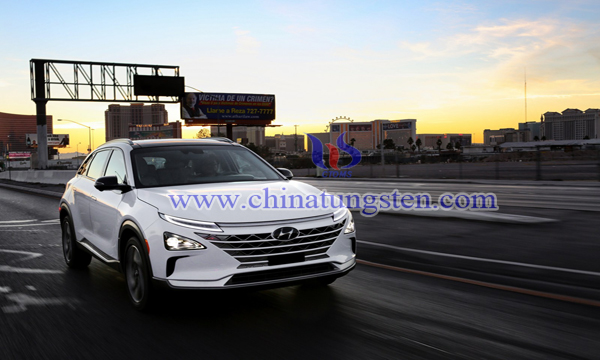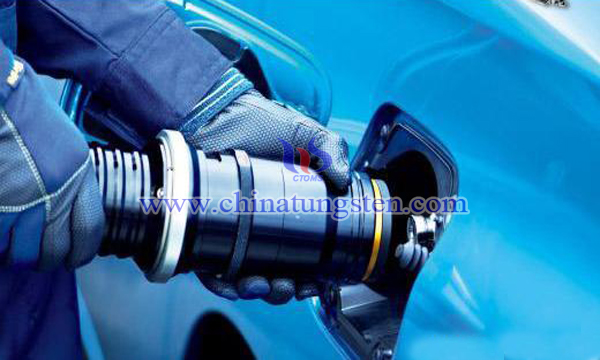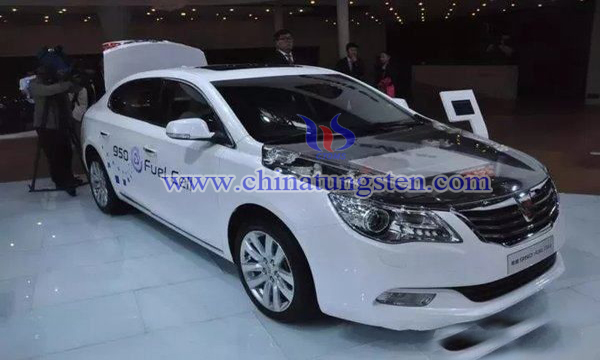Hydrogen Fuel Vehicle Era, Will Tungsten Still Have A Future?
- Details
- Category: Tungsten's News
- Published on Sunday, 09 September 2018 23:40
- Written by meiwei
- Hits: 612
At the 51st International Consumer Electronics Exhibition (CES) held in Las Vegas on January 9, 2018, Hyundai Motor Group unveiled a new generation of hydrogen fuel cell vehicle NEXO based on customizable platform, which is scheduled to go on sale in early 2018. This is the first of two fuel cell electric vehicles launched by Hyundai Automobile Group in 2020, which attracted wide attention of the media and audience. The car has a range of 595 kilometers, can be filled in five minutes, and will be equipped with mobile charging station to provide mobile charging service at any time.

Not only Japan and South Korea, but also China-made cars are beginning to make efforts in the field of hydrogen-fueled vehicles. On the evening of January 8, Xu Liuping, chairman of China First Automobile Group, said in an interview with the media that the red flag car, once the first independent brand of China's automotive industry, will start again in the field of new energy sources. Battery cars will begin to run in batches. In 2020, the new FME platform will launch a series of electric vehicles with a range of 600 kilometers. By 2025, the new red flag will introduce 15 electric vehicles.
All of the above news reveals a message that the new era of rapid development of hydrogen fuel vehicles has been opened. In recent years, Tesla has driven the development of the world's new energy electric vehicle market, but also brought about a boom in investment in the field of electric vehicles. In these two years, with the help of new energy subsidies and the policy of suspending fuel vehicles in 2030, the brand of electric vehicles in China has developed rapidly. However, in this blue sea, the largest investment is still lithium-based. Battery cars. Lithium-ion batteries are still facing many problems to be solved. In addition to questioning the battery's own safety and environmental protection, lithium-ion batteries also face other problems.
On the one hand, there is still a 200% gap between the battery technology and the full replacement of EV for ordinary household vehicles (energy density is more than 800Wh Wh/kg, cost is less than 0.3 yuan/Wh, today's figure). It is 300Wh/kg and 1 yuan /Wh). The limit of energy density of three yuan lithium battery is unable to support this target value. On the other hand, the world's proven lithium ores are not optimistic about supporting EV, and even deplete sooner than oil. In addition, the sharp rise in lithium and cobalt prices, the decline in state subsidies, resulting in soaring costs, lithium-battery vehicles also need to face the problem.

Therefore, the new energy vehicle will not only have one kind of battery car, and the high-performance battery car that can be popularized in the future will not be a three-component battery. In addition, the fuel cell, hybrid power, solar power and other energy sources represented by hydrogen energy are also developing simultaneously. The fuel cell is an electrochemical device that directly converts chemical energy into electrical energy. For a long time, platinum, ruthenium and other precious metals have been widely used because of their excellent catalytic performance.
However, platinum metals are expensive, lack of resources and produce toxic substances, which hinder their application in fuel cells and become the main bottleneck of the development of fuel cells. In order to speed up the commercialization process of fuel cells and reduce the cost of fuel cells, a lot of research has been done on the development of non-noble metal catalysts. More and more platinum-substitutable catalysts have been developed, which makes the cost of catalysts for hydrogen fuel cells have been reduced, especially tungsten-based catalysts.
In recent years, scientists have found that nano-tungsten-based materials (such as nano-tungsten carbide) have the most similar catalytic properties to platinum. This discovery is the gospel of the development of fuel cells. Scientists have found that not only tungsten carbide has good electrocatalytic performance, but also does not produce toxic by-products. Tungsten carbide-based materials are based on tungsten carbide. Many synthetic catalysts also have catalytic properties no less than platinum, they do not produce toxic by-products, are truly green catalysts, more importantly, they are cheaper and easier to commercialize popularity.

With the development of research, more and more tungsten-based fuel cell catalysts have been developed, such as titanium/tungsten, nickel/tungsten, tungsten/graphene and so on. It is said that some foreign teams have recently synthesized catalytic materials with metal elements including molybdenum, tungsten, Niobium and Tantalum, which can surpass the platinum metal completely. Whether this research can surpass the "valley of death" between laboratories and factories is still uncertain, but there is no doubt that tungsten catalysts can surpass the platinum metal completely. It will play an important role in the future fuel cell field. (China Tungsten online: Weiping)
Copyright Statement: This article is only used by China Tungsten Industry Association and China Tungsten Online. Any individual may not copy or reproduce it without written permission or without specifying the copyright and origin. Otherwise, it will be regarded as infringement and the website will be prosecuted for legal liability according to law.
- Tungsten Manufacturer & Supplier, Chinatungsten Online: www.chinatungsten.com
- Tungsten News & Prices of China Tungsten Industry Association: www.ctia.com.cn
- Molybdenum News & Price: news.molybdenum.com.cn
- Tel.: 86 592 5129696; Fax: 86 592 5129797; Email: sales@chinatungsten.com





 sales@chinatungsten.com
sales@chinatungsten.com